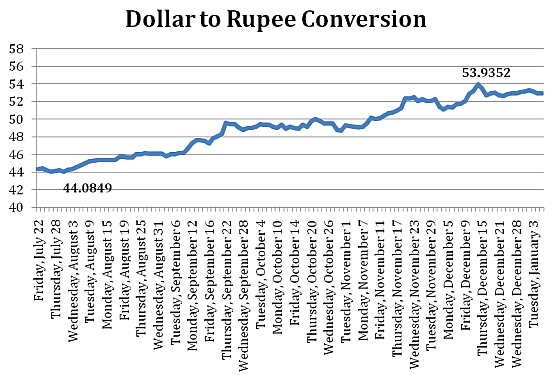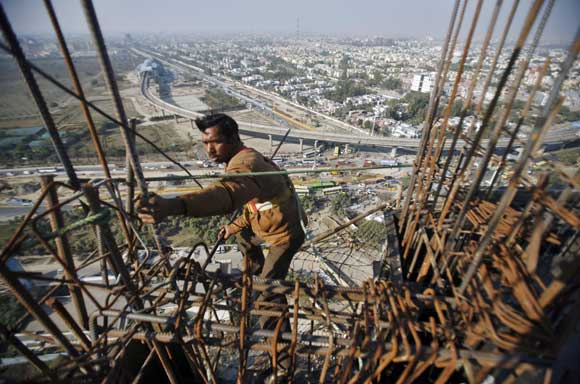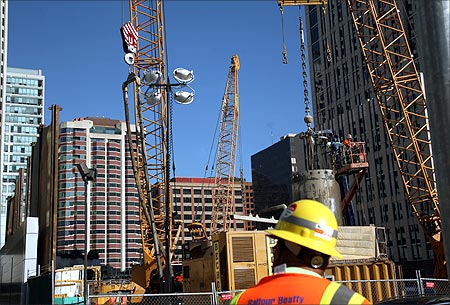Please Share::  India Equity Research Reports, IPO and Stock News
India Equity Research Reports, IPO and Stock News
Visit http://indiaer.blogspot.com/ for complete details �� ��
Visit http://indiaer.blogspot.com/ for complete details �� ��
While high interest rates, huge inventory of unsold stock is making one feel the prices of homes would come down, a fall in the Indian rupee over the past four months is making your dream homes expensive. Siddhesh Joglekar of Estatelister.com explains how.
The Indian rupee has depreciated by quite a bit over the past four months. We worked out the currency trend graph for the past 120 days and that clearly does not make a good read.
The rupee has gone from 44.08 to 53.93 in the past 4 months, a fall of nearly 20 per cent. Such fluctuation in the rupee has affected all sectors.
For example, the IT sector has benefitted since majority of their earnings are in dollars and with the worth of the dollar increasing, their income increased too (as rupee falls against the dollar, every dollar earns extra rupees).
This phenomenon has affected the real estate sector as well. Here we discuss four key ways in which the rupee depreciation has affected the real estate sector.
1. Cost of imported material
India imports some of the construction material, heavy machinery and even some percentage of cement. Import of these items worked out to be cheaper for the real estate construction sector before.
Now with the rupee depreciating, this equation has gone worse for the construction sector. Now it costs more to import goods from foreign lands. This has driven up the overall construction cost for every real estate project.
In some cases, this unexpected escalation of costs has upset the budgeting of developers and caused delays in the project delivery too.
Impact on the buyer: Mostly negative
Any cost escalation finally gets passed on to the buyer. This will be no different as well. Such fluctuation is going to make under construction properties dearer and resistant to significant discounts that the buyers expect.
2. Oil prices
Oil prices have gone up in the similar period as well. Oil is an important raw material in the construction process and its cost increase coupled with rupee depreciation has not gone well with the real estate sector and its cost management.
Since oil prices have gone from 75 dollars a barrel to 115 dollars a barrel -- a spread of nearly 50 per cent -- there is a lot of uncertainty over transportation prices etc and that has impacted the real estate.
Impact on the buyer: Mostly negative
This cost fluctuation has not really led to cost passing on. But this has caused an impact of delay in construction projects all over the country. A lot of construction projects have been delayed due to this factor and that has impacted the delivery schedule from a consumer perspective.
3. NRI demand
Just like every cloud has a silver lining, the rupee depreciation has a small silver lining for the industry professionals. In this case, the NRIs have basically spurred demand for a sector where high prices had made the demand supply situation unfavourable for the property developers.
From a non-resident Indian community perspective, the rupee depreciation has meant that Indian real estate is available at a discount and this has truly impacted the real estate sector in the IT sector hotspots like Pune, Bangalore, Hyderabad etc.
A large consumer base from among the December buyers in these cities were from the NRI population. Not only the NRIs, even the exporters have largely benefitted from this.
4. Growth drivers of real estate
With this phenomenon and lower than expected domestic demand for real estate, the growth drivers of real estate for 2012 has changed significantly. Now, the industry increasingly looks at investors and buyers as the demand side leaders of the real estate sector.
Note that this is happening because there is an inherent resistance to reduce prices among the developer community, and now that they are finding demand from overseas, this resistance to reduce prices has gone higher. Besides, the investors, which often find funding abroad -- both individual and institutional -- would find such investments in real estate lucrative as well.
Clearly, the rupee depreciation has added an unexpected and an unfavorable spin to the property rates from an Indian consumer perspective. However, there still isn't enough demand to bridge the demand supply gap, and even now, some downward movement in prices for certain projects can be expected, particularly if sales do not pick up in early 2012.






No comments:
Post a Comment